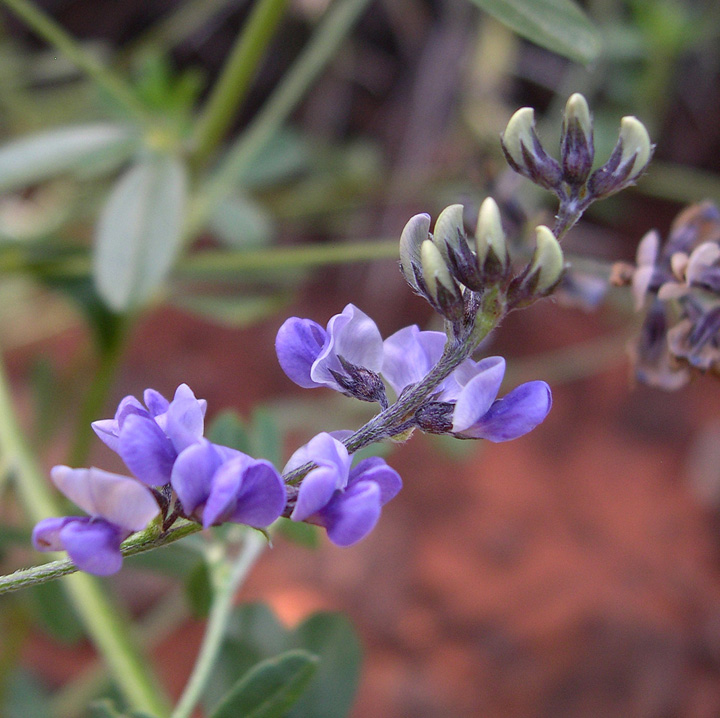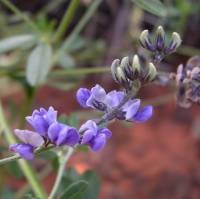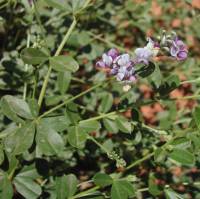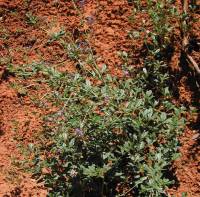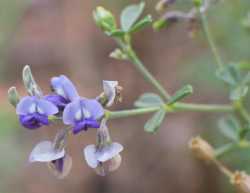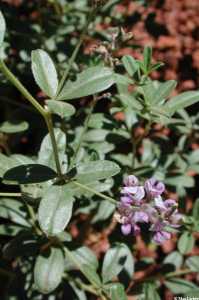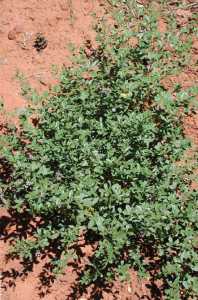Psoralidium tenuiflorum is a tall and branched. The leaves are mostly trifoliate and the leaflets are glandular dotted. The corolla is lavender. Psoralidium tenuiflorum is found in dry areas and in town at lower to middle elevation.
Duration: Perennial
Nativity: Native
Lifeform: Forb/Herb
General: Herbaceous perennials, 20-60 cm tall, stems erect, bushy-branching, herbage more or less strigose, gland-dotted, arising from long-creeping rhizomes.
Leaves: Alternate, most digitately 3-foliate, leaflets oblong to obovate, 1-4 cm long, strigose below, glabrous above, glandular-dotted.
Flowers: Violet to purple, corollas 4-7 mm long, bracts short and inconspicuous, calyx to 2 mm long, the lobes about as long as the tube and subequal, borne in slender racemes 1-4 cm long, pedicels 2-4 mm long.
Fruits: Ovoid pods 5-8 mm long, with a short, straight beak, the surface smooth and gland-dotted. Seeds singular.
Ecology: Found on dry slopes and plains or in open pine forests, from 4,000-7,500 ft (1219-2286 m); flowering May-September.
Distribution: North Dakota and Montana to Colorado, Arizona, and Mexico.
Notes: Look for this species under Psoralea tenuiflora in older texts. This species is fairly common, and its presence is often an indicator of overgrazing. Look to the gland-dotted herbage and pods, the purple to violet flowers, and the mostly digitately 3-foliate leaves to help identify this species. This plant is said to be poisonous to horses and cattle.
Ethnobotany: A decoction of the plants and roots was taken for consumption, an infusion of the roots was used for headaches, an infusion of the plant was taken or the leaves smoked for influenza, and a poultice of moistened leaves was applied to any body part for purification. The plant was used as an ingredient of a modern intoxicant made from mescal, the plant used several ways for sheep with coughs, and the plant tops were used to make garlands worn like hats in hot weather.
Etymology: Psoralidium is a diminutive of Psoralea, while tenuiflorum means with fine or delicate flowers.
Synonyms: Psoralea tenuiflora, many others, see Tropicos
Editor: LCrumbacher 2011
Erect, much branched, to 1 m, gray- strigose, rhizomatous; petioles 0.4-1 cm; lfls 3 or 5, narrowly elliptic to oblanceolate, subglabrous above, mostly 2-4 cm נ5-8 mm; racemes loose and open, 4-10 cm, on elongate peduncles exceeding the lvs; pedicels 1.5-3 mm; fls 1-4 per node, blue (white), 5-8 mm; cal hirsute and glandular-punctate, the tube 1.5-2 mm, the lobes narrowly triangular, acute, the lowest 1.2-1.8 mm, the other 4 shorter; fr flattened-ovoid, 7-8 mm; 2n=22. Dry prairies and plains; Mont. to Utah and Ariz., e. to Minn., Ind., and Mo. May, June. (Psoralea t.; Psoralea floribunda)
Gleason, Henry A. & Cronquist, Arthur J. 1991. Manual of vascular plants of northeastern United States and adjacent Canada. lxxv + 910 pp.
©The New York Botanical Garden. All rights reserved. Used by permission.


